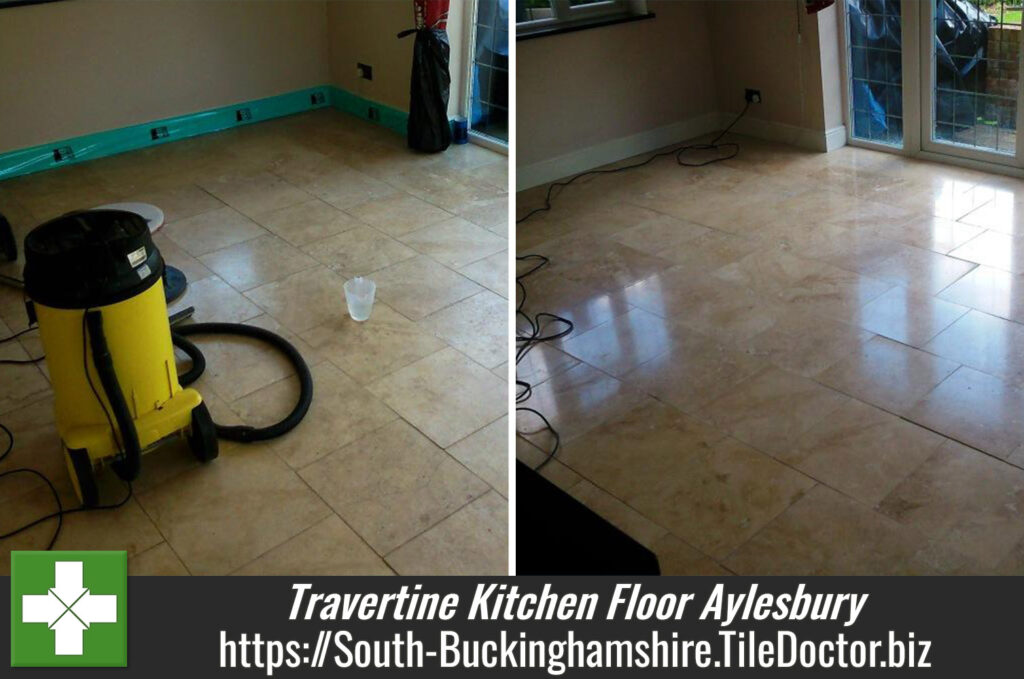Travertine is a type of Limestone which unique and distinctive features, making it a highly sought after and expensive type of natural stone tile. Not only is it a very attractive stone, it’s also a very useful building material. In fact, it’s been used since Ancient Roman times when it was the main component of temples, aqueducts, monuments, bath complexes, and amphitheatres.
In the modern era it remains popular, but to keep Travertine in fantastic condition it is necessary to ensure regular and professional maintenance. In this case seven years after this customer in Aylesbury had a Travertine tiled kitchen floor installed, the stone had significantly declined in appearance. Over time the sealant had worn away, allowing the dirt from everyday life to sink deep into the pores of the floor resulting in dirt becoming ingrained in the pores of the stone that the customer was unable to remove by themselves. Having tried hard to clean the floor to no avail – and keen to see the sheen restored to the tiles – the customer called me in for some expert assistance.

Burnishing and Cleaning a Travertine Tiled Kitchen Floor
As with all of our customers, I conducted an initial free on-site survey and demonstration clean for the customer. During the survey, I determined that the sealer had completely broken down and that the best option was to use our Tile Doctor burnishing system to restore the tiles to a like-new appearance. We demonstrated this process, which involves the application of different diamond encrusted pads of varying grit to grind away dirt and refine the polish on the stone, on one of the most badly soiled tiles. The results were very impressive and the customer remarked on how much it transformed the tile.
After provision of a detailed written quote, the customer requested that I complete the service and two weeks later I was back to restore the whole floor.
The process took two days. On day one, I used the Coarse, Medium and Fine diamond burnishing pads to resurface the tile. This process uses water in conjunction with the burnishing pads to gently remove the top layer of the tile, along with any ingrained dirt, old sealer and scratches. Once I had completed the whole floor, I got to work cleaning the grout. For this, I used a strong solution of Tile Doctor Pro Clean, our reliable alkaline cleaner, in combination with a handheld scrubbing brush.
I then rinsed the floor, removed any excess water, and allowed it to dry overnight.
Sealing a Travertine Tiled Kitchen Floor
The following day, I returned to the property to seal the floor. Before I could seal it I needed to perform a dry buffing process using the fourth diamond encrusted pad with a Very fine grit. This process closes up the pores in the floor and provide a good quality sheen to the tiles.
Finally, I applied two coats of Tile Doctor Ultra Seal. This is an impregnating sealer that penetrates the tiles to provide maximum stain protection, especially in food preparation and serving areas. This sealer is completely transparent, so it does not affect the natural look of the stone.

Once the second coat of sealer had dried, I buffed the floor one more time to remove any excess sealer. The customer was absolutely delighted with the result, leaving the following feedback:
“Andrew did an excellent job on our kitchen floor. The tiles are much cleaner than before and I’ve never seen them so shiny! Andrew was professional, knowledgeable, and very polite and friendly. Would not hesitate to recommend him!”


For the regular cleaning of polished stone we recommend using a specialist cleaning product such as Tile Doctor Stone Soap which helps maintain the patina. If you wish to use something else the read the label in detail first, most supermarket tile cleaners are only suitable for glazed tiles as they are acidic and this will erode and reduce the life of the sealer over time.